Do Yoga Practices Help With Pet Obedience Training?
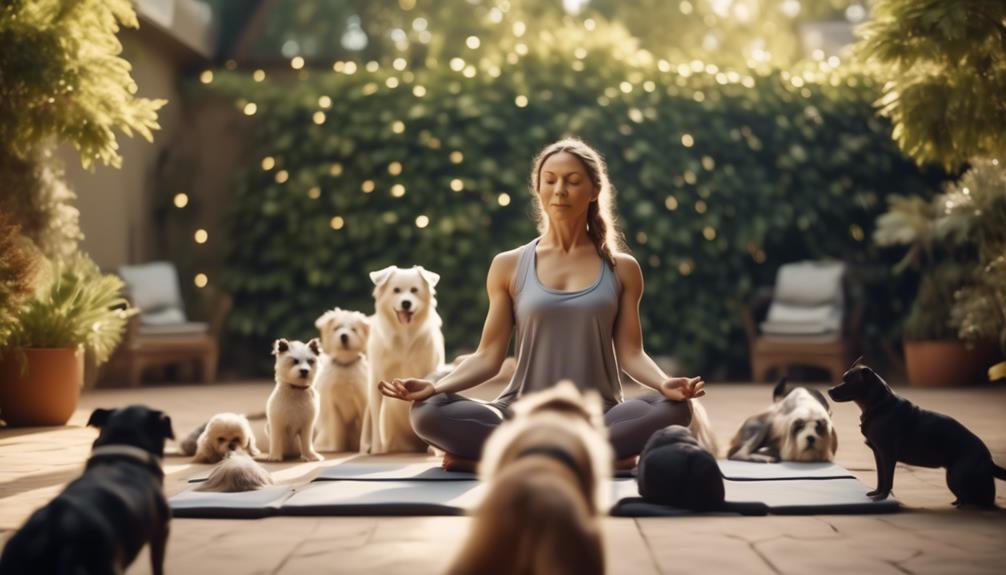
By combining yoga techniques with obedience training, you can create a more mindful and peaceful environment for both you and your pet. This can lead to better focus and concentration during training sessions. Additionally, incorporating yoga poses such as downward dog or warrior pose into your training routine can help improve your pet's flexibility and balance. These poses can also be used as rewards for successfully completing commands, providing positive reinforcement in a fun and engaging way. The deep breathing and relaxation techniques used in yoga can help reduce stress and anxiety in both you and your pet, making the training experience more enjoyable for everyone involved.
Key Takeaways
- Yoga practices promote calmness, focus, and stress reduction, which can benefit pet obedience training.
- Incorporating yoga into training creates a positive and relaxed environment for both the trainer and the pet.
- Mindfulness and relaxation techniques learned through yoga can improve communication and understanding between the trainer and the pet.
- Yoga teaches self-control and impulse management, which can be helpful in addressing behavioral issues like hyperactivity, aggression, and anxiety in pets.
The Connection Between Yoga and Pet Obedience
The connection between yoga and pet obedience can be seen through the incorporation of mindfulness and relaxation techniques into training exercises. Yoga has long been known for its ability to promote calmness, improve focus, and reduce stress. These same principles can be applied to pet behavior training, particularly in the case of dogs.
Incorporating yoga into dog training can have numerous benefits. Firstly, it helps to create a positive and relaxed environment for both the pet and the trainer. By practicing mindfulness and relaxation techniques, the trainer can approach the training session with a calm and centered mindset, which in turn helps to create a peaceful and receptive atmosphere for the dog. This allows for better communication and understanding between the trainer and the pet.
Furthermore, yoga can be used as a tool to teach dogs self-control and impulse management. Through various yoga poses and exercises, dogs can learn to focus their attention, control their impulses, and respond to commands in a disciplined manner. These practices can be particularly helpful in addressing behavioral issues such as hyperactivity, aggression, and anxiety.
Benefits of Incorporating Yoga Into Training

Incorporating yoga into pet obedience training offers a multitude of benefits for both the trainer and the pet. The practice of yoga can enhance the training experience and deepen the connection between the trainer and their furry companion.
Here are some key benefits of incorporating yoga into pet obedience training:
- Increased focus and concentration: Yoga encourages mindfulness and helps improve the trainer's ability to concentrate on the task at hand, allowing for better communication with the pet.
- Improved body awareness: Practicing yoga helps the trainer become more aware of their body and movements, which can be particularly useful when teaching specific commands or cues to the pet.
- Enhanced flexibility and strength: Yoga poses and stretches help improve the trainer's physical fitness, enabling them to keep up with their energetic pets and perform training exercises more effectively.
- Reduced stress and anxiety: Yoga promotes relaxation and stress reduction, creating a calm and positive environment for both the trainer and the pet during training sessions.
- Deepened bond and connection: The shared experience of practicing yoga together can strengthen the bond between the trainer and their pet, resulting in a more harmonious and effective training relationship.
Key Yoga Techniques for Pet Obedience
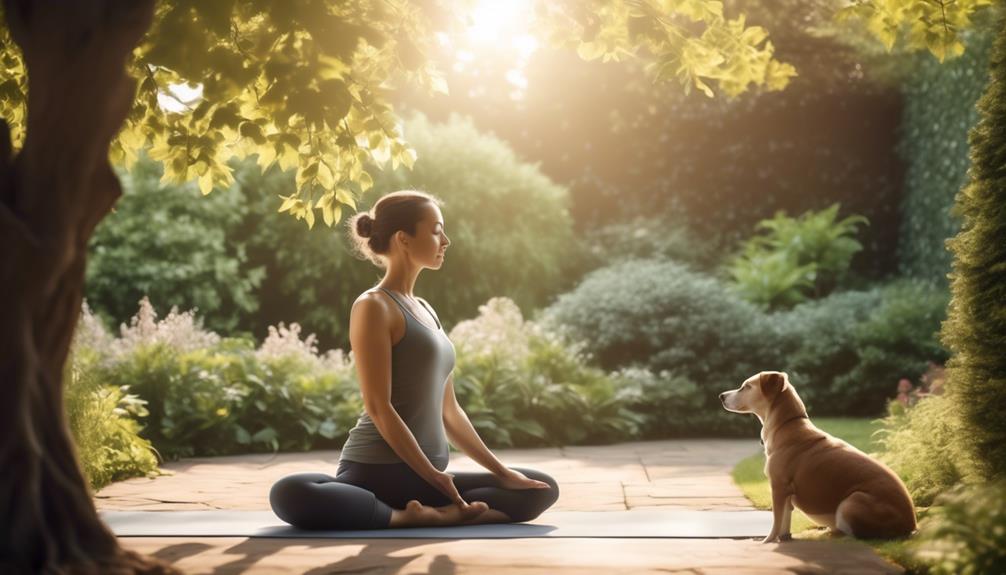
Key yoga techniques for pet obedience include:
- Breath control for focus
- Body awareness and alignment
- Calming techniques for relaxation
These techniques can be instrumental in training pets to be obedient and responsive to commands. By incorporating these yoga techniques into training sessions, pet owners can enhance their ability to communicate effectively with their pets and establish a sense of calm and control.
Breath Control for Focus
Breath control plays a crucial role in enhancing focus during pet obedience training through key yoga techniques. By incorporating specific breathing exercises and mindfulness techniques, pet owners can create a calm and focused environment for their furry companions. Here are five ways breath control can improve pet obedience:
- Deep breathing exercises help owners relax and project a sense of calmness, which can positively influence their pets' behavior.
- Controlled breathing techniques can be used to redirect a pet's attention when they become distracted or agitated during training sessions.
- Focusing on the breath promotes mindfulness, allowing both the owner and pet to be fully present in the training moment.
- Breathing exercises can help regulate emotions, preventing owners from becoming frustrated or impatient during the training process.
- Consistent breath control establishes a rhythm and routine that pets can easily recognize and respond to, enhancing their overall obedience.
Body Awareness and Alignment
To further enhance pet obedience training, pet owners can cultivate body awareness and alignment through specific yoga techniques.
Body awareness is the ability to consciously understand and feel the position, movement, and posture of one's body. By developing body awareness, pet owners can better understand their own bodies and how they communicate with their pets. This awareness can help them recognize subtle physical cues from their pets and respond accordingly, improving communication and training outcomes.
Alignment, on the other hand, refers to the optimal positioning of the body in each yoga posture. By practicing proper alignment, pet owners can improve their own posture, strength, and balance, which can positively impact their ability to train and handle their pets.
Mindfulness, a key component of yoga, can also be applied to pet obedience training, helping pet owners stay present and attentive to their pets' needs and behaviors.
Incorporating body awareness and alignment techniques from yoga into pet obedience training can lead to improved communication, enhanced training outcomes, and a deeper connection between pet and owner.
Calming Techniques for Relaxation
Implementing calming techniques from yoga can be beneficial for promoting relaxation in pet obedience training. By incorporating pet-friendly poses and mindfulness exercises, pet owners can create a peaceful environment that encourages their furry friends to remain calm and focused during training sessions.
Here are five key techniques to consider:
- Downward Dog: This pose helps dogs stretch their muscles and release tension, promoting relaxation.
- Child's Pose: This pose encourages dogs to feel safe and secure, helping them relax and reduce anxiety.
- Breathing Exercises: Teaching dogs to focus on their breath can help them remain calm and centered during training.
- Gentle Massage: Massaging your pet can stimulate the release of endorphins, promoting relaxation and trust.
- Mindfulness Walks: Taking your dog on mindful walks allows them to explore their surroundings while staying present and calm.
Creating a Calm Environment for Training
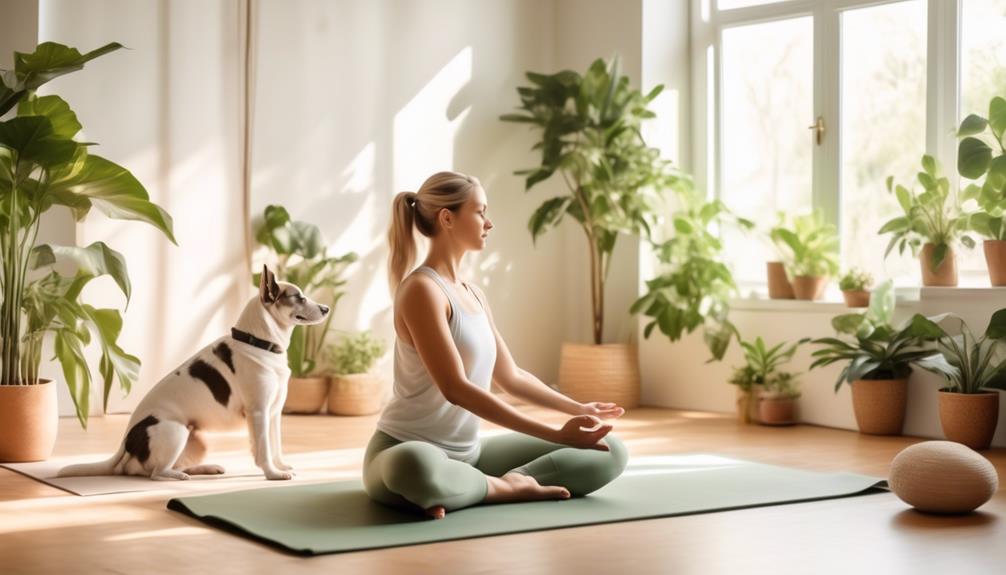
Creating a calm environment for training is essential when using yoga practices for pet obedience. By providing a peaceful and soothing atmosphere, pets are more likely to feel relaxed and receptive to instruction.
Tranquility aids in fostering obedience as it allows pets to focus and learn in a stress-free environment.
Peaceful Training Environment
A serene and tranquil environment is essential for effective pet obedience training. Creating a peaceful training environment can greatly contribute to the success of your training sessions. Here are five key elements to consider:
- Calm surroundings: Choose a quiet and clutter-free area where distractions are minimized.
- Soft lighting: Use soft, natural lighting or dimmer switches to create a soothing atmosphere.
- Comfortable temperature: Ensure the training space is neither too hot nor too cold, allowing your pet to feel relaxed.
- Pleasant scents: Incorporate calming scents, such as lavender or chamomile, to promote relaxation.
- Relaxing music: Play soft instrumental music or nature sounds to create a peaceful ambiance.
Soothing Atmosphere for Pets
To ensure a peaceful and calm environment for pet obedience training, it's important to consider the sensory elements that can contribute to a soothing atmosphere.
One effective way to create such an environment is by incorporating yoga practices for stress relief and meditation into the training routine. Yoga, with its focus on relaxation and mindfulness, can help both pets and their owners achieve a state of calm.
By practicing deep breathing exercises and gentle movements, pet owners can create a serene atmosphere that promotes better focus and concentration during training sessions.
Additionally, incorporating meditation techniques can further enhance the calming effect. Taking a few moments to quiet the mind and encourage a sense of inner peace can greatly benefit both pets and their owners, leading to a more effective and enjoyable training experience.
Tranquility Aids Obedience
By incorporating yoga practices for stress relief and meditation, pet owners can create a calm environment that aids in obedience training. Mindfulness exercises and positive reinforcement techniques can be beneficial in promoting tranquility during training sessions.
Here are five ways pet owners can create a peaceful atmosphere for effective obedience training:
- Establish a designated training area that's free from distractions.
- Use soft lighting and soothing music to create a calm ambiance.
- Practice deep breathing exercises to promote relaxation for both the pet and the owner.
- Incorporate gentle stretching exercises to release tension and create a sense of calm.
- Utilize positive reinforcement techniques, such as treats and praise, to reward desired behaviors and reinforce a calm and focused mindset.
Enhancing Communication Through Yoga Practices
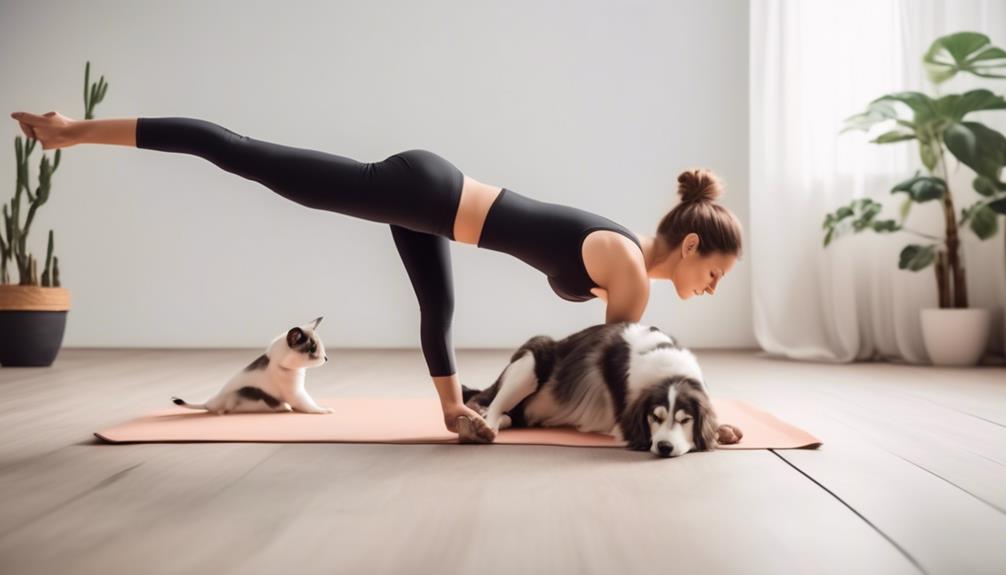
Enhancing communication between pet owners and their animals can be achieved through the incorporation of specific yoga practices. By combining breathing exercises and mindfulness techniques, pet owners can establish a deeper connection with their furry friends, leading to improved obedience training outcomes.
Breathing exercises are a fundamental aspect of yoga that can help both humans and animals relax and focus. By practicing deep, conscious breathing, pet owners can create a calm and centered environment, allowing their pets to feel more at ease. This relaxed state promotes open communication between the owner and pet, making it easier to convey commands and expectations.
Mindfulness techniques, such as meditation and body awareness exercises, can also enhance communication with pets. When pet owners practice mindfulness, they become more attuned to their own thoughts and emotions. This heightened self-awareness allows them to better understand their pet's behavior and needs. By being present in the moment and paying attention to their pet's cues, owners can respond appropriately and effectively during training sessions.
To further illustrate the benefits of incorporating yoga practices into pet obedience training, consider the following table:
| Yoga Practice | Benefits for Communication |
|---|---|
| Deep Breathing | Creates a calm environment |
| Meditation | Enhances self-awareness |
| Body Awareness | Improves understanding |
| Mindful Listening | Enhances responsiveness |
| Mantra Chanting | Establishes a positive bond |
Building Trust and Bonding With Your Pet
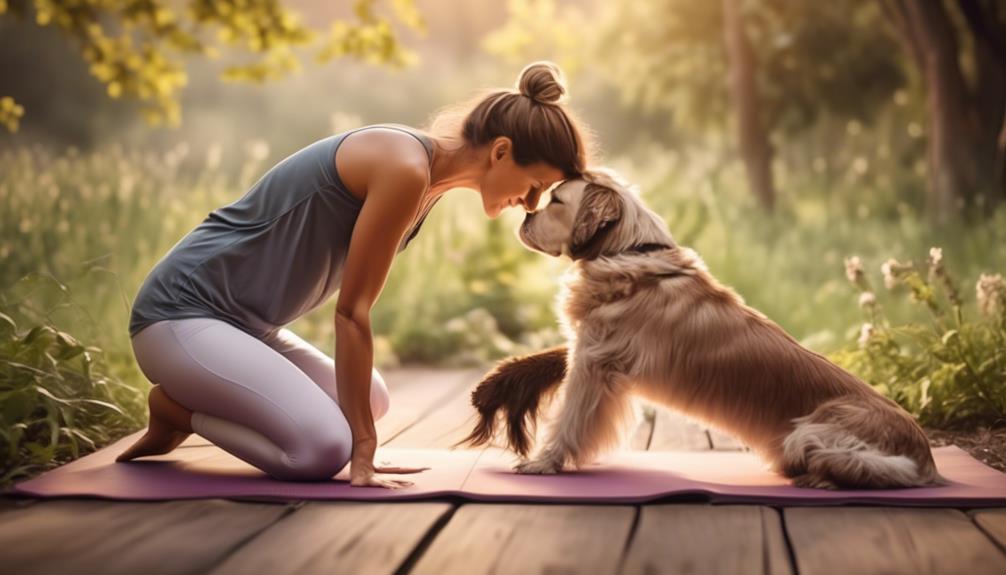
Building trust and establishing a strong bond with your pet is crucial for effective obedience training and a harmonious relationship. When it comes to building trust and bonding with your pet, there are several trust-building exercises and positive reinforcement techniques that can help strengthen your connection.
These techniques include:
- Consistency: Consistently following a routine and being predictable in your actions can help your pet feel secure and develop trust in you.
- Positive reinforcement: Rewarding your pet with treats, praise, or playtime when they exhibit good behavior reinforces their trust in you and encourages them to repeat that behavior.
- Physical contact: Regularly petting, cuddling, and grooming your pet not only strengthens your bond but also helps them feel safe and loved.
- Training sessions: Engaging in regular training sessions with your pet not only teaches them obedience commands but also strengthens the bond between you through communication and cooperation.
- Quality time: Spending quality time with your pet, such as going for walks, playing games, or simply relaxing together, helps create positive associations and build trust.
Integrating Yoga Into Your Training Routine
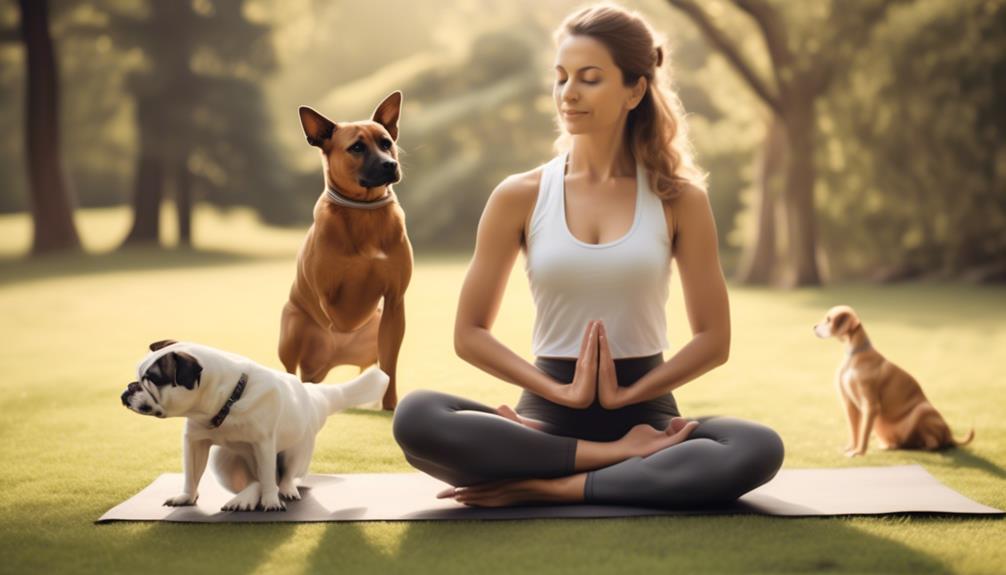
Incorporating yoga into your pet obedience training routine can provide numerous benefits for both you and your furry companion.
Yoga postures and meditation techniques can help create a calm and focused environment, making it easier for your pet to learn and follow commands. By practicing yoga alongside your pet, you can enhance your bond and strengthen the communication between you.
Yoga postures such as Downward-Facing Dog and Warrior II can help improve your balance and stability, enabling you to maintain a steady posture while giving commands to your pet. These postures also require deep breathing and concentration, which can help you stay centered and patient during training sessions.
Meditation techniques, such as mindfulness and visualization, can help you cultivate a sense of calmness and clarity, allowing you to better understand and connect with your pet's needs.
Integrating yoga into your training routine can also have physical benefits for both you and your pet. Regular yoga practice can improve your flexibility, strength, and overall fitness, making it easier for you to engage in physical activities with your pet. Similarly, certain yoga poses can help your pet develop better posture, balance, and coordination.
Frequently Asked Questions
Can Yoga Practices Completely Replace Traditional Pet Obedience Training Methods?
Yoga practices can be a complementary approach to traditional pet obedience training methods. While they offer numerous benefits, such as improved focus and relaxation, they should not completely replace obedience training for optimal results.
Are There Any Specific Yoga Poses That Are More Effective for Training Pets?
Certain yoga poses can be beneficial in pet obedience training, as they help strengthen the bond between pet and owner. Poses like Downward Dog can teach dogs patience and focus, while Tree Pose can enhance their balance and coordination.
Can Practicing Yoga Improve My Pet's Overall Behavior and Temperament?
Practicing yoga can improve a pet's overall behavior and temperament. It helps in strengthening the bond between the owner and the pet, reducing anxiety, and promoting a calm and relaxed state of mind.
How Frequently Should I Practice Yoga With My Pet to See Noticeable Improvements in Their Obedience?
To see noticeable improvements in pet obedience, it is recommended to practice yoga with them regularly. The frequency of yoga sessions will determine the effectiveness of the practice in enhancing their behavior and temperament.
Are There Any Potential Risks or Limitations to Incorporating Yoga Into Pet Obedience Training?
Incorporating yoga into pet obedience training may have risks and limitations. It is important to consider the physical abilities and limitations of both the pet and the owner to ensure safety and effectiveness.









